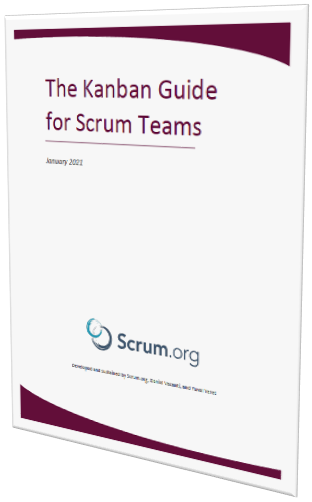Scrum with Kanban
Add flow concepts to improve your value delivery
Delivering products is complex work and for more than 25 years, people have been using Scrum to do so. Scrum is a framework in which you add practices that make sense for your Scrum Team or organization to build and define the overall process. Kanban can be used to enhance that overall process and improve how your Scrum Team works.
Why Add Kanban Practices to how Scrum Teams Work?
Kanban is defined as a strategy for optimizing the flow of value through a process that uses a visual, work-in-progress limited pull system. The flow-based perspective of Kanban can enhance and complement the Scrum framework and its implementation. Teams can add complementary Kanban practices whether they are just starting to use Scrum or have been using it all along. Central to the definition of Kanban is the concept of flow. Flow is the movement of value throughout the product development system. Kanban optimizes flow by improving the overall efficiency, effectiveness, and predictability of a process.
Optimizing flow in a Scrum context (without changing Scrum) requires defining what flow means in Scrum. Scrum is founded on empirical process control theory, or empiricism. Key to empirical process control is the frequency of the transparency, inspection and adaptation cycle - which we can also describe as the Cycle Time through the feedback loop.
When Kanban practices are applied to Scrum, they provide a focus on improving the flow through the feedback loop; optimizing transparency and the frequency of inspection and adaptation for both the product and the process. When adding Kanban to Scrum, nothing in the framework changes - the Scrum Guide still applies. The Kanban practices may however add to the existing accountabilities, events and artifacts.
The Kanban Guide for Scrum Teams
 The Kanban Guide for Scrum Teams is the result of a collaboration between members of the Scrum.org community and leaders of the Kanban community. Together, they stand behind The Kanban Guide for Scrum Teams. It is their shared belief that professional product development practitioners can benefit from the application of Kanban together with Scrum.
The Kanban Guide for Scrum Teams is the result of a collaboration between members of the Scrum.org community and leaders of the Kanban community. Together, they stand behind The Kanban Guide for Scrum Teams. It is their shared belief that professional product development practitioners can benefit from the application of Kanban together with Scrum.
This guide does not replace or discount any part of the Scrum Guide. It is designed to enhance and expand the practices of Scrum. This guide assumes the reader is operating a process using the Scrum framework. Therefore, the Scrum Guide applies in its entirety. The Understanding the Kanban Guide for Scrum Teams blog is a great companion read to the guide and understand some of the terms in the Professional Scrum with Kanban Glossary
Overcoming Common Myths
This webcast co-presented by Daniel Vacanti who helped to develop the Kanban Method for knowledge work and managed the world’s first project implementation and Professional Scrum Trainer Steve Porter, helps teach concepts that will challenge how you view both Scrum and Kanban by discussing common myths and busting through them with actions in how to:
- Improve your Sprint forecasting using common Kanban metrics
- Improve your Kanban team’s kaizen with Scrum’s events, roles and artifacts
- Combining the Kanban practices with the Scrum Framework will enhance the collaboration across your teams
- And more
Core Kanban Practices and Flow Metrics
Focusing on flow and reducing batch size is a way to improve your delivery of value. The 4 Core Kanban Practices and 4 key flow metrics can help you focus on understanding and improving the flow of work.
Core Kanban Practices:
- Visualization of the Workflow
- Limiting Work in Progress (WIP)
- Active management of work items in progress
- Inspecting and adapting the team’s Definition of Workflow
Flow Metrics:
- Cycle Time
- Throughput
- Work in Progress
- Work Item Age
Little’s Law which states that in general, the more things that you work on at any given time (on average) the longer it is going to take for each of those things to finish (on average), helps quantify the need for these practices and metrics. This whitepaper goes into detail about why Little's law is important and the need to apply such concepts to how teams work.
Professional Scrum with Kanban Training
There is a myth that teams need to choose between using Scrum or Kanban. There are many benefits to optimizing the flow of work in Scrum by leveraging Kanban practices. In this course, students will learn the benefits of using Scrum and Kanban together.
Students will learn how to optimize their workflow by adding four Kanban practices to Scrum:
- Visualizing the Sprint Backlog workflow on a Kanban board
- Limiting Work in Progress (WIP)
- Actively managing work items in progress
- Continually inspecting and adapting the way the team uses flow optimization
By leveraging these practices, teams improve transparency, collaboration and self-management, ultimately improving their ability to achieve Sprint Goals at a sustainable pace. In addition, this course has a focus on helping students track and manage flow metrics to provide more predictable delivery patterns, ultimately helping them to overcome common delivery challenges with getting to “Done”. Students will leave with a better understanding of what good Kanban looks like and how to implement it within a Professional Scrum environment.
Learn more about Scrum with Kanban Training
Where to Find More
There are many resources including videos, blog articles and more related to Nexus. Go to the Resource Center and to find more.